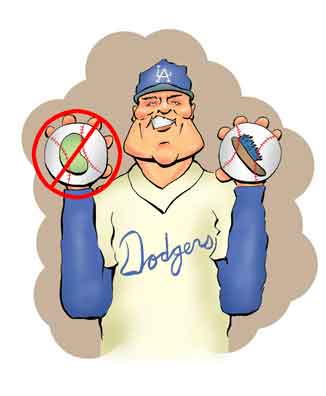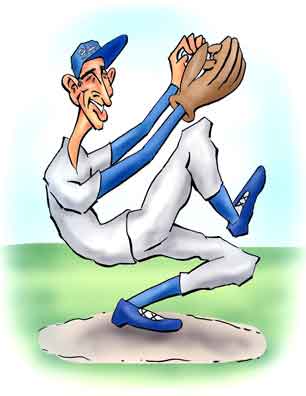
Don Drysdale
Don Drysdale
Using the Old Bean?
In 2007, the Supreme Court of California ruled that a batter getting hit with the ball was simply part of the game. So even if the pitcher deliberately tried to smack the batter, any official action against the pitcher had to be limited to what was stipulated by the rules of the game.
On the other hand, Don Drysdale, one of the better pitchers in baseball, stoutly maintained he never deliberately threw a "bean ball". Instead said Don he was an inside pitcher.
Strictly speaking, an inside pitch is simply throwing the ball over the four inches of the plate nearest the batter. One purpose of the inside pitch is that if the batter hits the ball, the ball strikes the bat nearer the handle and not on the "sweet spot". So the ball will go foul or pop-up for an easy out.
We said that's one of the purposes of the inside pitch.
Of course, throwing inside can send the ball close to the batter. And if it's inside enough, the ball can clobber him. It's those balls that are thrown inside to deliberately hit the batter that we call the "bean ball".
Now admittedly there is a continuum of insideness. A ball thrown inside and with the intent of making the batter stand back further is called a "brush back" pitch. Usually a brush back pitch is also thrown high.
Now throwing inside is not against the rules. But if the umpire thinks a pitch was tossed to deliberately hit the batter, that is not allowed.
As the rules say:
Rule 8.02: Throwing at the Batter
d. The pitcher shall not intentionally pitch at the batter
If, in the umpire's judgment, such a violation occurs, the umpire may elect either to:
- Expel the pitcher, or the manager and the pitcher, from the game, or
- may warn the pitcher and the manager of both teams that another such pitch will result in the immediate expulsion of that pitcher (or a replacement) and the manager.
But how can you tell if a pitch is deliberately tossed at the batter? Even the best pitchers have balls slip away from them now and again.
A characteristic of an intentional bean ball is - and kids, don't try this at home (or anywhere else) - that it is aimed behind the batter. That's because immediately after the throw, the batter only has time to see that the ball - moving at 90 miles an hour - is heading his way. His instinct, then, is to jerk back, and he will move into the path of the ball.
Intermediate between the bean and the brush is the knock down pitch. A knock down is intended to - not necessarily physically strike the batter - but to make them hit the dirt. As pitcher Bob Gibson said, a knock down was a brush back pitch with attitude.
As to who was the most notable of the inside or brush back pitchers, maybe we should listen to the experts - the batters themselves. Once while Willie Mays was chatting with Mickey Mantle and Duke Snider, the topic of the pitchers came up. At one point Willie commented, "No one was meaner than Drysdale."
Mickey agreed. "He thought it was funny," he said. "He'd walk up to me before a game and start poking me in the ribs and ask 'Where do you want it today?'" Don was so formidable that it wasn't unknown for a batter to opt out of a lineup because Don was pitching.

Sandy Koufax
Of course, the other formidable pitcher on the Dodgers team in the 1950's and 60's was Sandy Koufax. Sandy was also a brush backer. What really ticked Sandy off was not so much if you got a run, but if you got a run without having an actual hit. When you next stepped up to the plate, you better watch out.
One player who learned about Sandy's opinion was Lou Brock. Sandy walked Lou on four balls. Then Lou stole second and when the next batter smacked a fly ball, Lou ran to home for the score.
Don knew what was coming as he commented to infielder Jim Lefebvre. Sure enough. The next time Lou stepped to the plate, the ball smacked him right in the back. Being hit by a pitched ball, Lou was entitled to take first base. Lou with assumed nonchalance began trotting down the line but before he reached the base he collapsed. He had to be carried off the field on a stretcher.
California courts notwithstanding, some people wonder why actions that would be considered felonious assault on any other job is just - quote - "part of the game" - unquote - if you're standing on a pitcher's mound. Today there is an increasing outcry against the bean since batters are getting hit with even greater frequency.
After he retired Don said he thought the problem was because pitching inside had become a lost art. And if the pitchers couldn't properly pitch inside, then the batters couldn't learn how to avoid the ball.
In 1959, Don and his first wife, Ginger, appeared on Groucho Marx's "You Bet Your Life" (Don's above average height is most noticeable). Even though Don had only been in the majors for three years, he had already established himself as a star pitcher. We admit that here Groucho went a bit over the top with his wisecracks and interrupted too much to be really funny.
Of course, Don did more than just brush back batters. In 1968, he went a record 58 consecutive innings without letting a batter score. And it wasn't until twenty years later, in 1988, that Orel Hershiser - also on the Dodger's team - broke that record. When Don, by the way, was caught on-camera warmly congratulating Orel, the announcer commented, "Oh, don't give me that stuff where guys always give it that, 'Oh, yeah, records are made to be broken. I was rooting for the kid.' Fat chance! Whose name you want in the record book, yours or someone else's?"
Sometimes baseball experts snort that Don "only" won 209 games and had a win percentage of 55.7 %. But Don was also a Cy Young winner, pitched in five World Series, and in one season - remember Don was a pitcher - batted 0.300. Sometimes Don was even sent in as a pinch hitter.
Don's second wife, Anne Meyers, played basketball at UCLA, and in 1976 she represented the United States on the Olympic team. She also played for the professional Houston Angels.
Both Don and Anne went into broadcasting after their active sports years and both were elected into their respective Halls of Fame, Don in 1984 (Baseball) and Anne the next year (International Women's Sports). Sadly Don lived only nine years longer and unexpectedly died of a heart attack in 1993.
References
Whatever Happened to the Hall of Fame?, Bill James, Simon and Schuster, 1995.
"Don Drysdale's 'Inside' Pitch", The New York Times, July 9, 1979.
Discussion/Interview, Willie Mays, Mickey Mantle, and Duke Snider, Discussion, ca. 1990.
"Baseball's Tragedy, Fear: the Bean Ball", David Kindred, Sporting News, July 7, 1996.
"MLB Needs To Act on Bean Balls - But We Should Know Better", Jack Moore, The Guardian, May 12, 2017.
"Randy Johnson, the Babe Ruth of Bean Balls", The Wall Street Journal, Darren Everson, June 3, 2009.
"Battering the Batter", Adam Felder, The Atlantic, May 5, 2015.
"MLB Batters Getting Hit by Pitches At a Historic Rate - and Tensions Are High", Scott Boeck, USA Today, April 12, 2018
"You Bet Your Life", Groucho Marx (host), George Fenneman (announcer), Don Drysdale (guest), Ginger Drysdale (guest), February 26, 1959, National Broadcasting Company, Internet Movie Data Base.
Super Duper Baseball Bloopers, Baseball Park Magazine, 1989.
"Rules of Interest", MLBNetwork.com.